JEOL has introduced a triple-quadrupole mass spectrometer called JMS-TQ4000GC. The spectrometer can precisely quantify trace concentrations of regulated chemicals in tap water and also residual or trace pesticides in agricultural materials.
Through this spectrometer, quantitative analysis of persistent environmental pollutants, like PCBs and dioxins, is also simplified.
JEOL’s Triple Quad GC-MS/MS enables chemists to investigate an unlimited number of samples rapidly and acquire comprehensive analyses of compounds of interest. The spectrometer acquires the fastest Selected Reaction Monitoring (SRM) switching speed available in the industry at 1000 channels/second. Multiple target compounds can be analyzed by chemists with excellent precision.
Fast and Accurate Quantitative Values
The JMS-TQ4000GC triple-quadrupole mass spectrometer offers three distinct technologies for rapid analysis:
- Short cell—the short collision cell collects the ions for a specified short time and subsequently ejects them in a pulse. Users can reduce the noise level of the signal by synchronizing the timing between the acquisition of signal and the ejection of pulsed ions, thus achieving high-sensitivity analysis.
- Ion accumulation—the short collision cell collects ions and expels them in quick pulses. Users can reduce the noise level of the signal by synchronizing the timing between the acquisition of signal and the ejection of pulsed ions, thereby achieving high-sensitivity analysis.
- Fast GC method—the TQ4000GC uses a small-diameter, short-length capillary column with a rapid oven temperature ramp. This feature decreases the measurement time and considerably speeds up routine analysis. The Fast-GC chromatogram has narrow peak widths and therefore rapid transitions are needed. For Fast-GC measurement, short collision cell technology offers sufficient high-speed transitions without any sensitivity loss.
Easier and Faster Data Analysis
The TQ4000GC data analysis software “Escrime™” has an easy-to-read layout and can be effortlessly operated. The software was developed to enable concurrent multi-component analysis. Furthermore, chromatograms are organized in a vertical column, making it simple for users to compare their samples.
The Escrime™ software, integrated with the compound “slideshow” function, makes it easy for chemists to validate all components and samples.
Wide Range of Organic Analyses
Apart from the regular electron ionization (EI) source, the JMS-TQ4000GC mass spectrometer also supports optional photoionization (PI) and chemical ionization (CI) sources, allowing users to easily acquire molecular weight data. In addition to doing GC-MS, the system can also perform two types of direct probe experiments—direct exposure probe (DEP) for labile and high-boiling point compounds and direct insertion probe (DIP) for insoluble compounds.
Easy Maintenance
Users do not require any tools to eliminate the ion source from the main body. The vacuum system has a high pumping capacity that allows users to continue the analysis more rapidly.
Three Technologies Provide Accurate Quantitative Values Faster
The short collision cell can accumulate ions and eject the pulsed ions. This allows users to achieve rapid measurement and maximum sensitivity. Users can also reduce the measurement time by making high-speed SRM switching at 1000 transitions/second, the fastest in the industry. This enables them to enhance throughput for complete analysis.
Technology 1—Ion Accumulation
The short collision cell accrues the ions and creates a pulse. Users would acquire data only when there is an ion pulse and not at other times when there is just noise. This aspect considerably enhances the signal-to-noise ratio, delivering unparalleled reproducibility and excellent sensitivity.
Technology 2—Short Cell
The short collision cell allows users to promptly eject all the ions inside the cell. This offers the industry’s fastest SRM and also allows excellent selectivity because of the elimination of interfering ions.
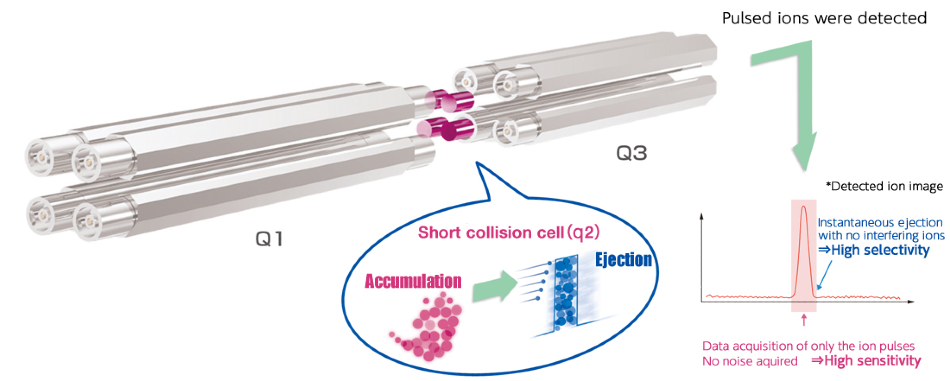
Technology 3—Fast GC
Using short, small-diameter capillary columns and quickly ramping up the temperature of the GC oven allows for shorter measurement times, thus considerably enhancing the number of samples that can be processed every hour. Since the chromatogram has reduced peak widths, rapid transitions are needed, which is where the potential of the short collision cell truly comes into force.
Conventional GC-MS measurement
Column: 30 m length, 0.25 mm I.D., and 0.25 μm film thickness. Total 40 minutes.
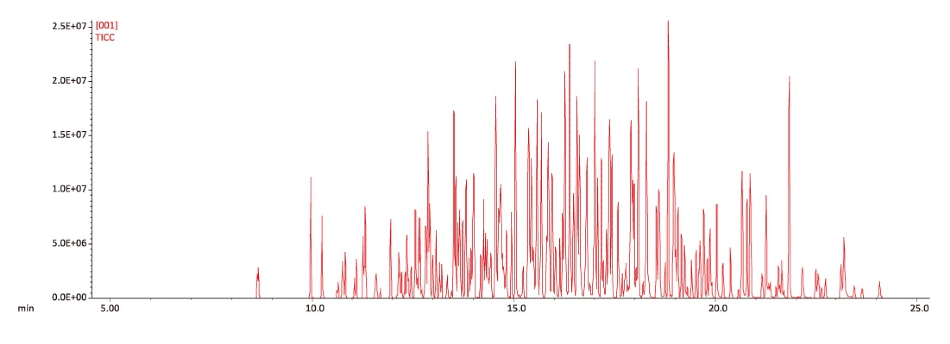
Fast GC-MS measurement
Column: 20 m length, 0.18 mm I.D., and 0.18 μm film thickness. Total 15 minutes.
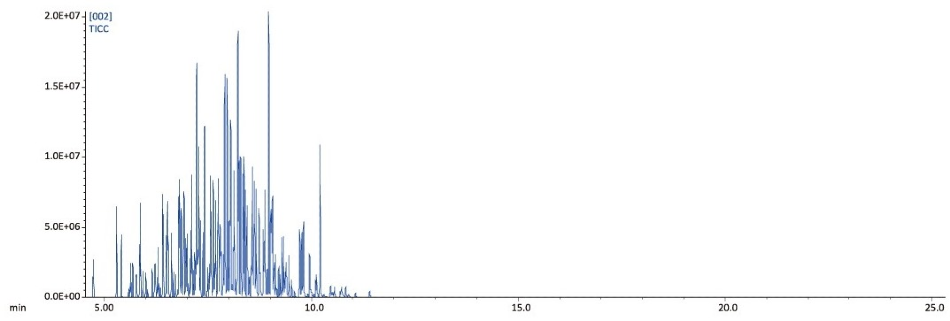
Easier and Faster Data Analysis
Data Analysis Software for Multi-Target compounds “Escrime™”
- Software has been developed to truly remove “pain points” for regular operation
- Complete dedication to achieve simple operation and an easy-to-read layout to support users’ needs that otherwise cannot be fulfilled by traditional systems
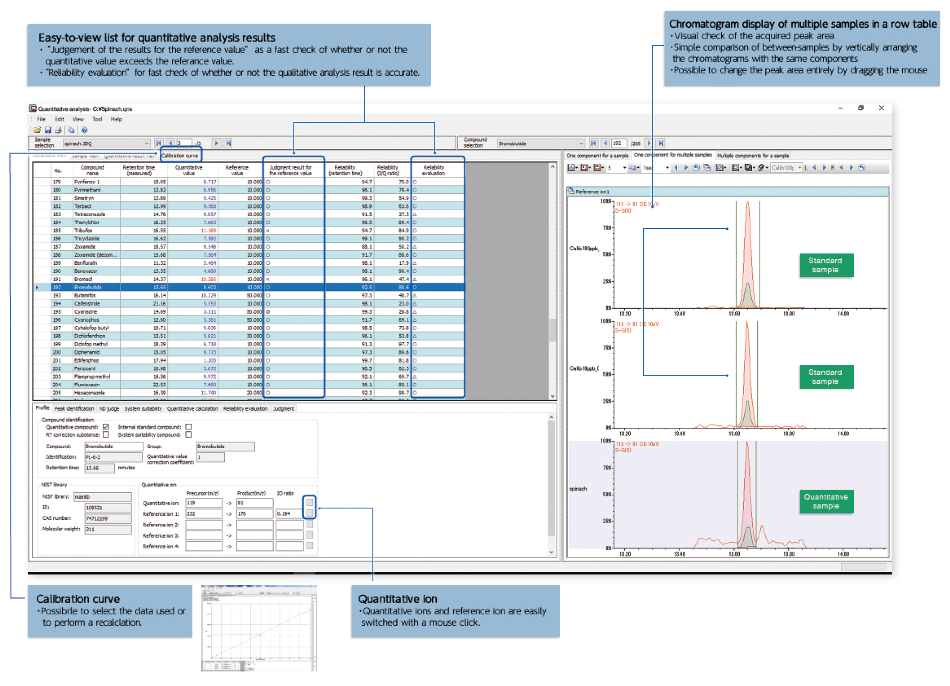
Slideshow for Data Check (Compound Slideshow Function)
- Users can visually check the calibration curves and chromatograms that switch at a fixed timing
- Users can check the calibration curves for every pesticide component and the single-column display of the chromatograms with the slideshow function
- If a section needs to be corrected, the slideshow can be stopped and the peak can be reevaluated
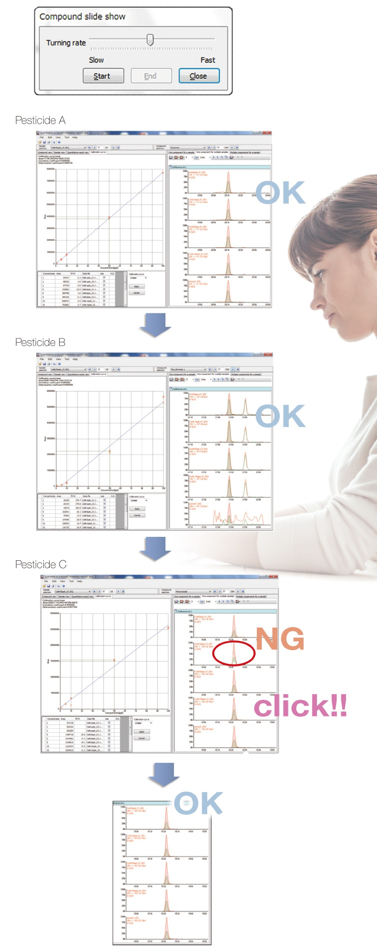
Easy Maintenance
Easy to Clean-Up the Ion Source, and Resume Analysis Quickly
- The measurement recovery time is very short, thanks to the high evacuation capability of the vacuum pump
- No tools are required to remove the ion source

Key Features
- Fastest SRM switching speed in the industry—1000 transitions/second
- Short collision cell for higher throughput and higher sensitivity with shorter acquisition times
- Easy-to-use and robust software for data analysis and reporting
- Easy to clean and maintain
- Direct probes—direct exposure probe (DEP) and direct insertion probe (DIP)
- CI, EI (standard), and PI (optional) sources
- Rapid ejection of pulsed ions without crosstalk (ion interaction among SRM channels)